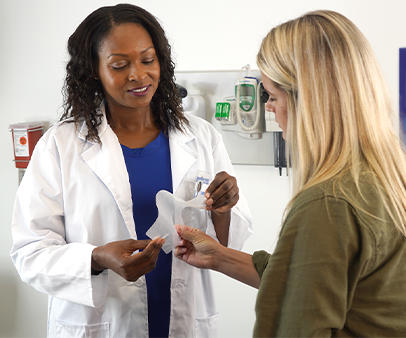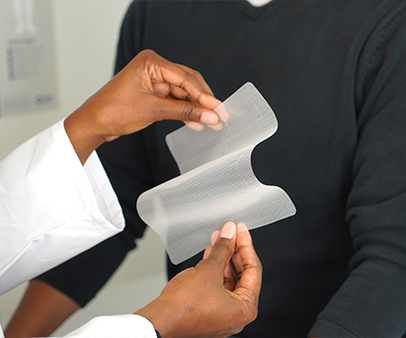Greg's Hernia Journey: From Pain to Recovery
Greg Gildersleeve lives the snowbird lifestyle, splitting his time between Michigan and Arizona. With family connections in both places, including his son Jason, daughter, and grandchildren in the Phoenix area, Greg enjoys the best of both worlds.
Before the hernia started interfering, life was full of movement and activity. From walking the golf course and swinging a club several times a week to working maintenance up north in the summer and exploring Arizona’s mountains in a side-by-side, staying active was just part of the routine. Bending, lifting, and playing with grandkids came naturally—whether it was maintaining the campground, riding motorcycles, or participating in social games with friends at the park, being physically engaged was second nature.
"We spend half a year in Michigan, and then we spend the other half down here in Arizona," Greg explains.
A Passion for Golf and an Active Lifestyle
An avid golfer for over 50 years, Greg carries on a family tradition that began with his grandfather and father.
"Golf is one of the few sports that you're in control of your destiny. It's not a team sport," he reflects. "If you're doing well, you're doing well, and it's nice for the accolades, but if you do bad, you also have to take the drumming and the teasing from your friends."
Beyond golf, Greg maintains an active lifestyle that includes:
- Working as a maintenance person at his Michigan campground during summers.
- Motorcycle riding.
- Taking his side-by-side into the Arizona mountains.
- Social activities with friends in both locations.
The First Signs of Trouble
"I didn't really know what having a hernia or anything like that was all about," Greg admits.
The first symptoms appeared as pains. At first, he didn't give it much thought, but the pain persisted, often forcing him to lie down. The symptoms weren't constant—they would come and go unpredictably, sometimes with gaps of a week or more between episodes.
One day while golfing, the pain hit so suddenly and intensely, Greg had to leave the course and lie down in a van just to get relief. It wasn’t constant, but when it came on, it was enough to stop him in his tracks—sometimes while doing something as simple as standing around and chatting with friends. That’s when he knew it was time to take action.
A Family Connection Leads to Diagnosis
Fortunately, Greg's son Jason has worked in the hernia repair field for over a decade. He sees the full picture—the good, the bad, and the complications that can arise when hernias go untreated. Working in the field, he’s up to speed on the latest surgical techniques and technologies, and he knew both the medical risks and the impact this was having on his dad’s lifestyle. When Greg described his symptoms, Jason recognized them immediately.
"So it was pretty much a classic 'Dad, you got a hernia' type deal."
Jason was able to guide him through the process, connecting him with a trusted surgeon and offering insight into what to expect. His biggest worry? That his dad would bounce back too fast. “He was chomping at the bit to get back out there, and I knew he needed to give his body the rest it needed to heal properly.”
Jason connected his father with Dr. Howard, a surgeon he has worked with professionally for years. The diagnosis was quick and clear: Greg had an inguinal hernia on one side and was developing another on the opposite side. Dr. Howard recommended repairing both at once.
Dr. Howard’s Take on the Case
Patients frequently come in with concerns about mesh for hernia repairs—often asking if non-mesh options exist. He explains to them that some type of mesh is necessary to provide the strength and security needed to prevent hernia recurrence, in his experience.
Dr. Howard describes bioabsorbable meshes as excellent options because they eventually disappear from the body. What makes these meshes unique is their process of hydrolysis, essentially turning into water and being absorbed, while leaving behind a scaffold of tissue that remains strong and secure. This allows the abdominal wall to normalize while maintaining the integrity of the hernia repair.
In his practice, he explains to patients that the bioabsorbable mesh will dissolve within approximately two years, but during that process, the repair is expected to remain intact and prevent hernia recurrence. He believes in providing patients with comprehensive information about all surgical options, including open surgery, laparoscopic, or robotic approaches, along with detailed explanations of mesh choice—a true shared care experience.
Understanding the Cause
While Greg had always understood hernias to result from overexertion or heavy lifting, he hadn't initially connected his symptoms to a specific incident. His pain was intermittent, triggered by various activities, and always in the same area (midsection/groin). However, during our conversation, he recalled a telling moment dealing with a 2,000-lb. trailer:
"I had an incident when my trailer bounced off of my pickup truck. I'm in the middle of the street and jump out of my truck thinking ‘Oh, I'll put it back on’. Dumb move! I felt the pop as soon as I tried to lift it."
This realization reinforced an important lesson about aging and physical limitations: "You gotta be more careful and be more conscientious on what your limitations are."
Treatment with Bioabsorbable Mesh
Based on Jason's recommendation, Greg opted for a bioabsorbable mesh. "If it was J's words, he says it'd be the only mesh I'd want put into me," Greg recalls.
The surgery was scheduled quickly, and within two weeks of his diagnosis, Greg was in the hospital for a bilateral hernia repair (the repair of two hernias on opposite sides of the body, typically in the groin area). The bilateral hernia repair went smoothly, and to Greg's surprise, his recovery was easier than expected.
"I kept waiting for, you know, I always heard people talking about bags of peas. You're gonna have to drop the peas on your crotch and all this sort of stuff [he laughs]. I didn't have to ice for a long period of time or anything."
A Quick Return to Normal Activities
Dr. Howard advised Greg that recovery would take three to four weeks, and that prediction proved accurate. Just three weeks after surgery, Greg was back on the golf course.
"Me and the bride hung out around the pool and took in the Arizona sun," he says of his recovery period. When he did return to golf, he noticed something interesting: "I actually thought I played a little better golf when I started afterwards, because you're not swinging as hard. You're a little more tempo."
Reflecting on Hernia Repair
Based on his own experience, Greg encourages others with hernias to seek treatment promptly rather than delaying:
"If they're afraid to have the surgery, they should not be. I've spoken to some people over the last few years that have had hernias and they're afraid to get 'em done. I'm sitting back and I'm thinking, eventually this is gonna fester and it's gonna get worse. It's not gonna get better. It's not gonna heal itself."
Life After Recovery
More than a year post-surgery, Greg reports no limitations on his activities: "I feel as normal as I did before it ever showed up. There's nothing in my life at all right now that is on hold because of what I had."
He concludes with a simple statement of satisfaction: "I'm Greg Gildersleeve, and I'm happy with my hernia repair because I'm back to being able to play golf."
Every patient is unique, and your healthcare provider will work with you to determine the best course of treatment. If you have any questions or concerns, be sure to bring them up with your healthcare provider. You can find hernia surgeons in your area with Surgeon Finder.
The guidance provided in this article follows general rules that should be discussed with your doctor. This article is for informational and educational purposes only. It does not substitute for medical advice. If in doubt, always consult your doctor.
Related Articles
Join the HerniaInfo.com community! Get notified about our latest articles and updates on all things hernia as they become available.


